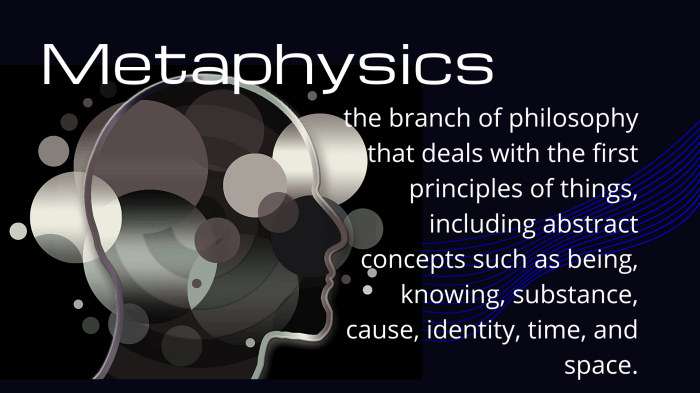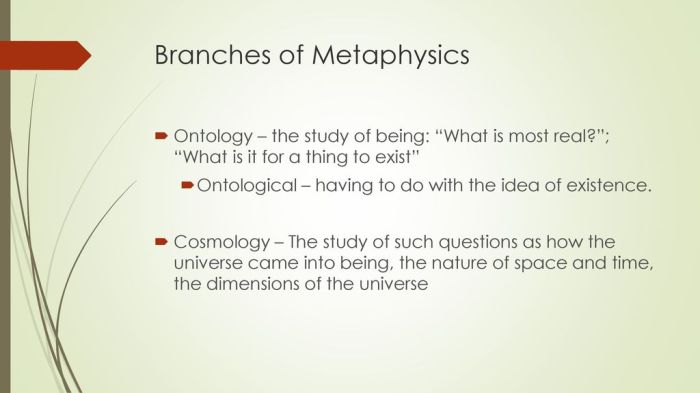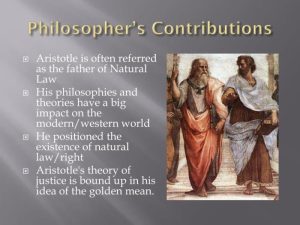
Delving into understanding metaphysics and its branches, this introduction immerses readers in a unique and compelling narrative, with a captivating overview of the significance of metaphysics and its main branches like ontology, epistemology, and cosmology. The exploration of the nature of reality beyond the physical world unfolds in a thought-provoking manner.
As we navigate through the realms of ontology, epistemology, and cosmology, we unravel the intricate layers of metaphysical concepts that challenge our perceptions and understanding of existence.
Introduction to Metaphysics and its Branches
Metaphysics is a branch of philosophy that deals with the fundamental nature of reality, existence, and being. It seeks to understand the underlying principles that govern the universe and our place within it. Metaphysics delves into questions that go beyond the physical world and explores the nature of reality at a deeper level.
Ontology
Ontology is a branch of metaphysics that focuses on the study of being and existence. It examines the nature of reality, the categories of being, and the relationships between entities. Ontology seeks to answer questions about what exists and how things exist in the world.
Epistemology
Epistemology is another important branch of metaphysics that deals with the study of knowledge and belief. It explores how we acquire knowledge, the nature of truth, and the limits of human understanding. Epistemology investigates questions related to perception, reason, and the validity of knowledge claims.
Cosmology
Cosmology is a branch of metaphysics that focuses on the study of the origin, structure, and evolution of the universe. It explores questions about the nature of space, time, and the cosmos as a whole. Cosmology delves into theories about the creation of the universe, the nature of reality, and our place within the vastness of existence.
Ontology
Ontology is a branch of metaphysics that focuses on the study of being and existence. It delves into questions concerning the nature of reality, existence, and the essence of things.
Role of Ontology in Metaphysics
Ontology plays a crucial role in metaphysics by exploring fundamental questions about the nature of being and what it means to exist. It seeks to understand the essence of existence and reality beyond the physical world.
Study of Being and Existence in Ontology
In ontology, scholars analyze the nature of being, the categories of existence, and the relationships between entities. It delves into questions such as what makes something real, the properties of existence, and the distinction between different types of beings.
Examples of Ontological Questions
- What is the nature of reality?
- What does it mean to exist?
- Are there different levels of existence?
- How do we define the essence of things?
Epistemology
Epistemology is the branch of philosophy that deals with the study of knowledge and belief. It focuses on understanding how we acquire knowledge, the nature of knowledge itself, and the justification for believing in certain things.
Connection to Metaphysics
Epistemology is closely connected to metaphysics as it deals with the foundation of knowledge and beliefs about reality. It raises questions about the nature of truth, the limits of knowledge, and how we can be certain about our beliefs.
Theories of Knowledge
- Rationalism: This theory posits that knowledge is primarily derived from reason and innate ideas. Rationalists believe that certain truths can be known a priori, or before experience.
- Empiricism: Empiricists, on the other hand, argue that knowledge comes from sensory experience and observation of the external world. They emphasize the importance of empirical evidence in forming beliefs.
- Skepticism: Skepticism challenges the possibility of knowledge altogether, questioning our ability to know anything with certainty. Skeptics doubt the reliability of our senses and the validity of our reasoning processes.
Cosmology
Cosmology, in the context of metaphysics, is the branch that deals with the study of the origin, evolution, and structure of the universe as a whole. It explores fundamental questions about the nature of the universe, its existence, and how it operates.
The Big Bang Theory
The Big Bang theory is one of the most widely accepted cosmological theories that explains the origin of the universe. It proposes that the universe began as a singularity, a point of infinite density and temperature, approximately 13.8 billion years ago. This singularity expanded rapidly, leading to the formation of galaxies, stars, and planets.
Multiverse Theory
The multiverse theory suggests the existence of multiple universes, each with its own set of physical laws and properties. These universes may exist parallel to our own, potentially offering explanations for the vastness and complexity of the cosmos. This theory raises questions about the nature of reality and the possibility of other realms beyond our observable universe.
Understanding Metaphysics through Painting
Painting has been a powerful medium for artists to explore metaphysical concepts and convey deep philosophical ideas. Through symbolism and visual storytelling, artists have created works that provoke thought and contemplation on the nature of reality, existence, and the unseen forces that shape our world.
Depiction of Metaphysical Themes in Paintings
- Artists often use symbols such as light, shadows, mirrors, and surreal landscapes to represent metaphysical ideas in their paintings.
- Themes like the duality of human nature, the passage of time, and the interconnectedness of all things are commonly explored in metaphysical paintings.
- Through intricate details and hidden meanings, artists invite viewers to reflect on the mysteries of the universe and their place within it.
Analysis of Famous Artworks Exploring Metaphysical Concepts
-
“The Persistence of Memory” by Salvador Dali: This surrealist painting with melting clocks challenges our perception of time and reality, inviting contemplation on the fluidity of existence.
-
“The Starry Night” by Vincent van Gogh: This iconic painting captures the artist’s emotional and spiritual experience of the night sky, delving into themes of cosmic connection and transcendence.
-
“The School of Athens” by Raphael: Depicting a gathering of great philosophers, this masterpiece explores the pursuit of knowledge, truth, and the eternal quest for understanding the nature of reality.
Use of Symbolism in Conveying Metaphysical Ideas
- Symbolism plays a crucial role in conveying metaphysical ideas in paintings, allowing artists to communicate complex concepts through visual cues.
- Objects like labyrinths, keys, mirrors, and celestial bodies are often used symbolically to represent deeper metaphysical truths and mysteries.
- Colors, shapes, and composition are also employed to evoke feelings of transcendence, unity, and the interconnectedness of the physical and spiritual realms.
Metaphysics in Performing Arts
Metaphysical concepts often find their way into the realm of performing arts, including theater and dance. Through the use of symbolic gestures, abstract narratives, and innovative performances, artists challenge perceptions of reality and existence, inviting audiences to contemplate deeper philosophical questions.
Portrayal of Metaphysical Concepts in Theater
Theater has long been a platform for exploring metaphysical themes, with playwrights and directors using symbolism, allegory, and surrealism to delve into questions of identity, consciousness, and the nature of reality. Plays like Samuel Beckett’s “Waiting for Godot” and Tom Stoppard’s “Rosencrantz and Guildenstern Are Dead” are prime examples of works that blur the lines between the mundane and the metaphysical, leaving audiences pondering the meaning of existence.
- The use of absurdist elements in plays challenges conventional notions of time, space, and logic.
- Characters often grapple with existential dilemmas and philosophical quandaries, inviting audiences to reflect on their own place in the universe.
- The blending of reality and illusion in theatrical performances creates a surreal atmosphere that mirrors the complexities of metaphysical thought.
Exploration of Metaphysical Themes in Dance
Dance, with its emphasis on movement, emotion, and expression, offers a unique canvas for exploring metaphysical concepts. Choreographers and dancers use body language, spatial relationships, and dynamics to convey abstract ideas and challenge traditional perceptions of reality.
- Dance performances often delve into themes of transformation, transcendence, and interconnectedness, echoing metaphysical theories of unity and harmony.
- The use of symbolism and ritualistic movements in dance pieces can evoke spiritual and metaphysical dimensions, inviting audiences to contemplate the unseen forces that shape our existence.
- Collaborations between dancers, musicians, and visual artists create multidisciplinary works that blur the boundaries between the physical and the metaphysical, offering audiences a holistic and immersive experience.
Philosophy and Metaphysics

Philosophy and metaphysics have a deep historical connection, as many ancient philosophers laid the foundation for metaphysical thought. Let’s explore the contributions of philosophers like Plato and Aristotle to the field of metaphysics, as well as modern perspectives on metaphysical questions.
Historical Connection
Philosophy and metaphysics have been intertwined since ancient times, with early philosophers pondering fundamental questions about the nature of reality and existence. The term “metaphysics” itself was coined by Aristotle, who used it to refer to the study of what is beyond the physical world.
Ancient Philosophers: Plato and Aristotle
- Plato, a student of Socrates, believed in the existence of a higher reality of Forms or Ideas, which he considered to be the true essence of things. His allegory of the cave symbolizes the journey from ignorance to enlightenment.
- Aristotle, a student of Plato, focused on empirical observations and logical reasoning. He categorized metaphysics into ontology (study of being), epistemology (study of knowledge), and cosmology (study of the universe).
Modern Philosophical Perspectives
- Modern philosophers have continued to grapple with metaphysical questions, often through the lens of logic, language, and science. Analytic philosophers like Bertrand Russell and Ludwig Wittgenstein have brought new insights into metaphysical debates.
- Contemporary philosophers explore topics such as identity, causation, free will, and the nature of time, pushing the boundaries of metaphysical inquiry in the 21st century.
Metaphysics in Photography

Photography, as an art form, has the unique ability to capture metaphysical concepts and themes through visual representation. Photographers often use various elements such as light, shadow, and composition to convey these abstract ideas in a tangible form. Through their work, they can evoke a sense of the transcendent and the spiritual, allowing viewers to contemplate deeper meanings beyond the physical realm.
Use of Light and Shadow
Photographers often manipulate light and shadow to create dramatic effects that symbolize metaphysical concepts. The interplay between light and shadow can represent the dualities of existence, such as good and evil, truth and illusion, or life and death. By playing with the intensity and direction of light, photographers can convey a sense of mystery and depth in their images.
Composition in Photography
The composition of a photograph is crucial in conveying metaphysical themes. The arrangement of elements within the frame can suggest harmony or discord, balance or imbalance, unity or fragmentation. Through careful composition, photographers can create visual metaphors that speak to the interconnectedness of all things, the cyclical nature of existence, or the search for meaning in a chaotic world.
Transcendence and Spirituality in Photography
Photography has the power to evoke a sense of the transcendent and the spiritual through capturing moments of beauty, wonder, or awe. By focusing on the sublime in nature, the sacred in everyday life, or the ineffable in human emotions, photographers can invite viewers to contemplate the mysteries of existence beyond the material world. Through their lens, they offer glimpses of the divine and the infinite, inviting us to connect with something greater than ourselves.
Exploring Metaphysics through Short Fiction
Short fiction offers a unique platform for authors to delve into metaphysical concepts and themes. Through narrative techniques, creativity, and imagination, writers can effectively portray abstract ideas in a compelling and thought-provoking manner.
Portrayal of Metaphysical Concepts
Short stories often serve as a canvas for authors to depict metaphysical concepts such as the nature of reality, existence, consciousness, and the supernatural. By constructing fictional worlds and characters, authors can explore these complex ideas in a more accessible and engaging way.
- Authors may use symbolism and allegory to represent metaphysical concepts in a concrete and relatable form.
- Through the interactions and experiences of characters, authors can raise philosophical questions about the nature of being and the universe.
- Metaphysical themes such as time, identity, and the afterlife can be explored through the lens of fiction, allowing readers to contemplate these concepts in a new light.
Narrative Techniques in Exploring Metaphysical Themes
Authors employ various narrative techniques to delve into metaphysical themes and engage readers in philosophical reflection.
- Use of unreliable narrators to challenge perceptions of reality and truth.
- Employment of nonlinear storytelling to convey the fluidity of time and existence.
- Incorporation of dream sequences and surreal elements to blur the boundaries between the physical and metaphysical realms.
Role of Imagination and Creativity
Imagination and creativity play a crucial role in depicting metaphysical ideas in short fiction, allowing authors to push the boundaries of conventional storytelling and explore the depths of philosophical inquiry.
Authors use their creative prowess to craft intricate worlds, characters, and scenarios that invite readers to ponder the mysteries of existence and reality.
Through the art of storytelling, authors can invite readers on a journey of introspection and contemplation, challenging them to expand their understanding of the metaphysical realm through the power of narrative.
Visual Graphic Arts and Metaphysics
Illustrations and digital art have the unique ability to convey complex metaphysical concepts through visual representation. Artists use various techniques, such as symbolism and surrealism, to explore and express abstract ideas related to the nature of reality, existence, and consciousness.
Symbolism in Visual Art
Symbolism plays a crucial role in visual art when representing metaphysical ideas. Artists often use symbolic imagery to convey deeper meanings beyond the surface level. For example, a simple object like a mirror may symbolize reflection and self-awareness, inviting viewers to contemplate their own existence and perception of reality.
Surrealism in Visual Art
Surrealism is another powerful tool used by artists to depict metaphysical concepts in their work. By blending elements of reality with the subconscious mind, artists can create dreamlike landscapes that challenge conventional notions of space and time. Surreal artworks often invite viewers to question the boundaries between the physical world and the realm of the imagination.
Combining Reality and Imagination
Artists skillfully combine elements of reality and imagination to create visually striking pieces that are metaphysically inspired. Through the juxtaposition of familiar objects with fantastical elements, artists invite viewers to explore alternative perspectives on existence and reality. This fusion of the real and the imagined allows for a deeper engagement with metaphysical themes in visual art.
In conclusion, the journey through understanding metaphysics and its branches unveils a rich tapestry of philosophical inquiry into the nature of reality, knowledge, and the universe. By exploring metaphysical themes in various art forms and disciplines, we gain a deeper appreciation for the profound questions that have captivated human curiosity for centuries.
Questions and Answers
What is the significance of metaphysics in philosophy?
Metaphysics delves into fundamental questions about the nature of reality and existence, providing a philosophical framework to explore the underlying principles of the universe.
How do artists convey metaphysical ideas in paintings?
Artists use symbolism and visual imagery to represent abstract concepts related to metaphysics, infusing their paintings with deeper meanings that transcend the physical realm.
What is the historical connection between philosophy and metaphysics?
Philosophy has long been intertwined with metaphysics, with ancient philosophers like Plato and Aristotle laying the groundwork for metaphysical thought that continues to influence modern philosophical perspectives.






